Ablikhos' poem 'On prayer'
John Bjarne Grover
The following poem of Ablikhos is from the source http://vivl-lixour.kef.sch.gr/?page_id=553&lang=el
Εις προσευχομένην
Ωσάν ηλιοτρόπιον γυρισμένη
είσαι προς τον βωμόν, ωραία ξανθή μου!
Δεν σε χορταίνει, ως σε θωρεί η ψυχή μου
με τόσο σεβασμό γονατισμένη.
Στο πρόσωπό σου λάμπει η γαλήνη,
ουράνιες ακτίνες το φωτίζουν,
της προσευχής δυο δάκρυα το στολίζουν
και χύνει η μορφή σου ευφροσύνη.
Και τόσην έχεις χάρι και μαγεία
και τόσο μου πλανάς το λογικό μου,
που μώρχεται αστοχώντας το Θεό μου
σε σένα να προσφέρω τη λατρεία.
Και μώρχεται θωρώντας σε, να κλίνω
σε σένανε μπροστά τα γόνατά μου•
μου φαίνεσαι Θεά στα βλέμματά μου
και δέησι σε σέναν' αποτείνω.
Συγχώρεσε, Θεέ, το φταίξιμό μου,
δική σου είναι αχτίνα η ωμορφιά της,
ναός σου, είναι, Πλάστα μου, η καρδιά της
κ' ελάτρευσα και Σε στο είδωλό μου.
My tentative and somewhat heuristic translation on basis of meagre knowledge:
On prayer
Like heliotropic circulation
you stand before the altar, my beautiful yellow!
It satisfies you not how my soul sees you,
bring[s] my observance to its knees.
In your face shines your tranquillity,
celestial radius of daybreak
decorated with two teardrops of prayer
and your form is cast on/in the elation.
And so much grace and magic you possess
and so much logic of my plane tree
and less and less it fails my God
when I give you my adoration.
And my vision of you decreases as it bends,
you before my knees,
Goddess appearing in my vision
and your prayer I address.
Forgive, Goddess, my faults -
your justice is the radius of your beauty,
your temple is my imagination - and its heart
I loved - and you - in my imagery.
(It is possible that 'In prayer' is a better translation). This poem describes the helicopters at the Danube river on 22 september 2013 - here from my diary that day:
I went for a walk along the Danube. A mighty cloud of helicopters came up along the river - five big military helicopters, two of them of the big size with two big rotors in either direction. They made an impressive sound which could have founded any church in stone age times. After they had disappeared up the river, there came another helicopter down again, a small civilian-looking one - I think it was white - it turned after it had passed me and flew back where it came from.
The 'two teardrops of prayer' are the two bigger helicopters with two large rotors each. These were every second with the smaller ordinary helicopters - could be the structure looked like a 1-3-5 with these teardrops interlaced. The vision decreased in size up the river untill it bent around some faraway curve of the river. It is possible that the small civilian one that came afterwards corresponded to the car that waited in the street intersection as I returned to Zinckgasse (cp. the recent news from Ecuador etc).
The vision or event was 5 days after the 'Wilderer' went amok in Annaberg in Melk. His name 'Alois Huber' arguably associates with 'Hu-Alois-ber' = 'Hubschrauber' = 'helicopter' - and some would probably leap to the conclusion that the vision could have been sent out from some military unit in order to 'complete' the Annaberg story.
I would believe that could not have been the case - not only because I fancy that there were some bridges and other obstacles that made it difficult, secondly it was too hyper-relevant to the poem of Ablikhos. There is even one small observation in the poem of Ablikhos that seems to prove that the vision would not have been engineered intentionally for making a hype for political use - that is the line
It satisfies you not how my soul sees you,
bring[s] my observance to its knees.
which tells of the nature of the relation between me and the passing helicopters with such precision that it cannot have been military envoys in the impressively resounding machines.
The place at the Danube river where I saw and heard this [3/9-23: as far as I remember, if it were not further up along the river] is not so far from the grove where I had photographed the 23 'imageries' a year and some weeks (463 days) earlier. It is possible to see traces of even this in the poem:
and so much logic of my plane tree
and less and less it fails my God
The word 'πλανος' ('planos') means something seductive or misleading (I take it here to be that which brings from the colour photos the quite different stories told in the thresholded photos) which I therefore here translate 'plane' - the tree described by Valery. The thresholding (here of my photos) is apparently a general theme of Ablikhos' poetry.
The word 'βωμός' ('bomos') means 'any raised place for standing on' - such as an altar.
There was the story from the street intersection and on the other side of the block of houses a small and somewhat raised flowerbed ('bede-hus' in norwegian means 'house of prayer') where a flower shot up that resembled the one where the 'cosmic visitor' could have landed when I threw it out in the nocturnal garden. The second burglary of the house followed probably not long after I had published the article on the web. Around the time of the assassination of the presidential candidate Villavicencio in Ecuador in the summer 2023, there were apparent sewerage maintainance work going on in the street - with two large cars - one had 'STRA' in big lettering on its side and the other 'Kanal-Technik'. These could perhaps add up to 'Strawberry Fields' - like that film 'Smultronstället' of Bergmann. (But I have not constructed the story - even if the elements could appear in an internet file of mine). I notice that the relevant name 'Isabelle Daniel' (the one inside the car which could have been waiting for me resembled her somewhat but as I bent down and looked inside, I concluded that it was not the one in the newspaper) is the political commentator in the newspaper 'Österreich' - and hence can be said to be 'the woman of Österreich'. I hope there are not too much arrangements going on for the time being for making me send off an 'M-ail' and things like that - for quasi claims that I try to coup the woman of Österreich'. I cannot afford more battles against gloves that could seem to feel that I have tried to coup their woman. I have certainly not.
Would 'Huber' count as 'the woman of 'Österreich'? But then genders could have to be tentatively swapped all over Europe for making that credible - like in the years from about 2013 and up to around 2020 or thereabout - and it is probably a futile game anyhow.
It is probably a poetic complex (like Ablikhos' poem) and not a matter of 'ejaculating guns' - as for quasi 'publishing of the poetry' that had been left after the poet's death. (After Huber's death?) 'Ikkelis Mablikhos' is not interesting.
The 'yellow' of the poem is here likely to be associated with the chinese Kangxi radical #201 as described in this file. Is it an austrian trauma that they cannot solve these matters of prayer (they are not even allowed to have military installations) with interpreting the 'überstreichen' in the sense of 'Ø-streich-en' - for 'Österreich'-en? Like 'Huber-streichen/schrauben' etc? But that is what makes it difficult - and then the 'glove in a face on a glittering ball' is that glove when it is streiched aslant - slammed in a face. It could be the formula 'you jump S over S' for the 'Ø kjempesår' ('Eugene Paisseau') = 'Ø giant wound' of WWII by 'Hitler's postcard' - making an identity of Norway by its national letter 'Ø' and Austria qua 'Ö-streich' that makes the latter of these look somewhat displaced. If that only leads to an even more ardent slam of the glove, it helps not much, rather the opposite. That could have been just that Huber-schrauber story from Annaberg. Alois Hub-er = Hub-alois-er = Hubschrauber = helicopter.
But that story of Annaberg was 5 days before I saw this vision (or event). However, just as for the story with Dickinson and Ablikhos, the quasi 'causality' is more likely to have gone the other way round. On this view, the story is more likely to be that History had prepared for this vision 463 days after the photos on the other side of the river - like History had prepared for the unrecognized norwegian poet through a couple of millenia - and therefore when Alois Huber lost his mind and shot police, it could have been for gaining authority - on behalf of the country - to this revelation of the Goddess of Ablikhos. This should lend credibility and authenticity to the idea of an identity with Norway qua 'Ø kjempesår' and that would reinforce the authority in the glove-slamming on a glittering ball - that glitter which was the transcendent luminosity of the lost manuscripts.
It is possible that this struggle has lasted since those days - and that the difference in gender between Huber and the Goddess could have been a background of the following years of more or less desperate gender-swapping attempts - for trying to assign to Huber the responsibility of the helicopter vision - instead of the Goddess whom Ablikhos talks of. That could also have explained several other phenomena in the mean time.
It is this which must be understood - that the attempt to gain this authority for being the body of the poet on the Wachstuch, ejaculating after the last respiration is out, is not the same as the intellectual property that should have been published: Such an ejaculation cannot be a publication of these poems - it is probably only nazi philosophy which perhaps could pretend that they could recognize such an identity- and that is not legal in Austria by the 1955 constitution.
Ablikhos' poem tells the poetic story. Could it even be the reason for an 'ABC-kos' with a repeated 'Die Nasty' on background of the man in the basement of his house in Annaberg? Could be that is not the story - but it is of course possible to see it afterwards.
I have conjectured that many - of even all - of Ablikhos' poems would relate in some essential way to my 23 photos from the grove at the Danube river. For the present poem, a relevant photo is clearly #7:
The Goddess even has an apparent sort of 'rotor' on her head. But is that to take the colour photo astray?
30 august 2023:
Ablikhos and the miracle of the sun in Fatima
It can be noticed how closely this poem approximates the socalled 'Miracle of the sun' that took place in Fatima at the end of the series of Madonna revelations in 1917 - it was on 13 october 1917. I quote from this article on the phenomenon:
"According to many witnesses, after a period of rain, the dark clouds broke and the Sun appeared as an opaque, spinning disc in the sky. It was said to be significantly duller than normal, and to cast multicolored lights across the landscape, the people, and the surrounding clouds. The Sun was then reported to have careened towards the Earth before zig-zagging back to its normal position".
The spinning disc is the 'heliotropic circulation' of Ablikhos' poem.
Ablikhos' life extended from the publication of Grassmann's 'Ausdehnungslehre' to this revelation in Fatima - from his birth on 18 march 1844 to his death on 28 november 1917 - soon after the outbreak of the russian revolution, in accordance with what the Madonna had said in Fatima some days before that again: She said to Lucia that Rusia had to turn around, otherwise she would spread her errors all over the world - and a few days later the russian revolution broke out.
Here is the original text and translation on the Vatican's website.
The apparently close affinity between the Fatima apparition of 13 october 1917 (with the 'miracle of the sun') and the russian revolution of 6 november 1917 is probably well known and could well have been the reason for the following quote from Weber (2001) p.122 - on Lenin soon after the power change of the revolution on 6 november 1917:
"...sah sich Lenin plötzlich als Sieger. Er lächelte und sagte zu Trotzki: "Der Übergang von der Illegalität und dem Umhergetriebenwerden zur Macht ist zu schroff. Es schwindelt einem", fügte er auf deutsch hinzu und machte mit der Hand eine kreisende Bewegung vor dem Kopf. "Nach dieser einzigen, mehr oder minder persönlichen Bemerkung, die ich von ihm anlässlich der Eroberung der Macht gehört habe", schreibt Trotzki, "folgte der einfache Übergang zu den Aufgaben des Tages". (Weber quotes Trotzki "Über Lenin", Frankfurt 1964:84)
For trying to decipher a cuneiform code out of the Fatima sun, I could recognize a parallel to the function of Tizian's "Bacchanal" (source Kennedy 2018 - see also this source) - for deciphering my photo #9 and the cuneiform sign LAL - in Tizian's "Ariadne and Bacchus" (source Kennedy 2018 - see also this source)in this photo #7. Tizian's "Ariadne and Bacchus" is here thresholded in two ways, with varying levels of parametre values, for highlighting different aspects of this 'miracle of the sun' in Fatima: The first part in terms of the 'sun' and its 'careening towards the ground' - the second part of how it 'zigzagged' back to normal position again:
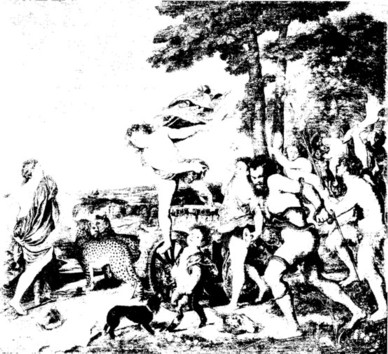
threshold level 1 |
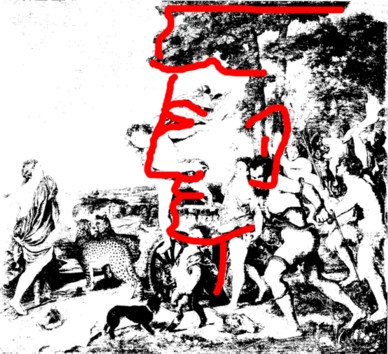
threshold level 1 annotated |

threshold level 2 |
Threshold level 1 shows the 'sun' and threshold level 2 shows the 'zigzagging' in the form of the stairway steps in the lower lefthand corner - of the container for fluids on the textiles. It is by searching for the same in photo #7 that the 'careening towards the ground' becomes visible in the form of a diagonal line across the colour version:
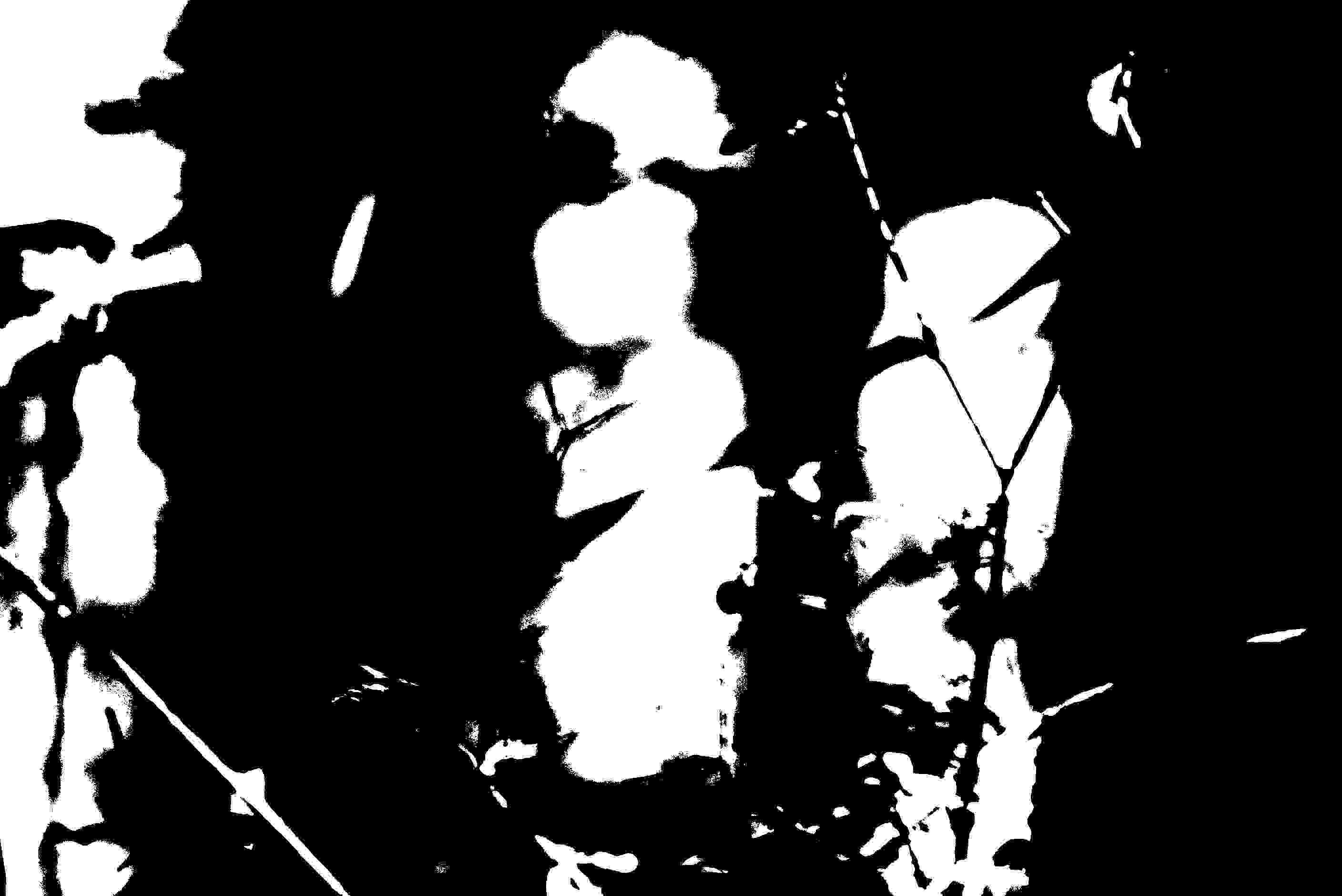
thresholded photo #7 |

the original colour photo |
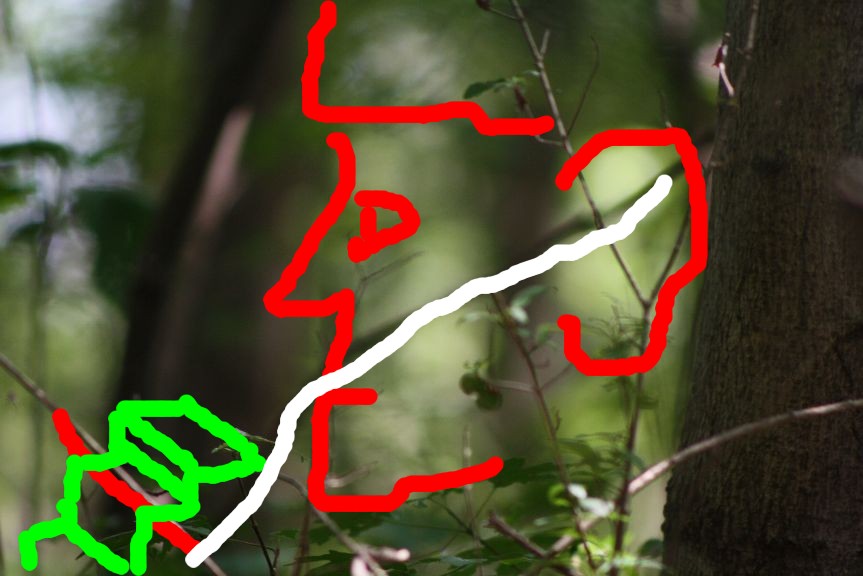
the elements from Tizian |
The stairway steps are only rudimentary or formally present as one diagonal and one vertical and one horizontal line.
Notice the vague outlines of Ariadne in the lefthand margin of this colour photo - she even seems to display a similar motion of her body and arm as in Tizian's artwork.
Assuming this to be 'the sun' in the form of 'the son', Tizian shows how the family comes 'rotating around the corner'.
Following the same logic as for photo #9 and the 'Bacchanal', what should be the other photo for recognizing a cuneiform sign? It could be the mirror-symmetric one to #7 - that is #(24-7) = #17 - the 'triptyk' which now shows the diagonal of the same formalistic 'stairway steps' in the righthand third instead of the lefthand on Tizian.
Trying to find a correlate to this in the cuneiform script (I use Hübner/Reizammer), I find that the sign ![]() = PAP = 'älter, Bruder, Vater, bewachen' can be used for the lefthand 'stairway' symbolism in terms of the single diagonal line. Since sumerian for 'Wasserlauf' (such as the Danube where the helicopters occurred) is
= PAP = 'älter, Bruder, Vater, bewachen' can be used for the lefthand 'stairway' symbolism in terms of the single diagonal line. Since sumerian for 'Wasserlauf' (such as the Danube where the helicopters occurred) is

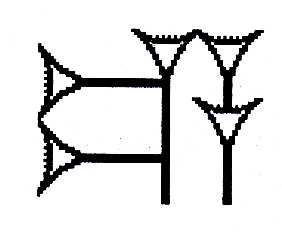 = PAP.E = pa5
= PAP.E = pa5
one can naturally recognize in the second part of this the 'E' = ![]() in the face in the righthand part of the first of the following:
in the face in the righthand part of the first of the following:

the elements from Tizian |
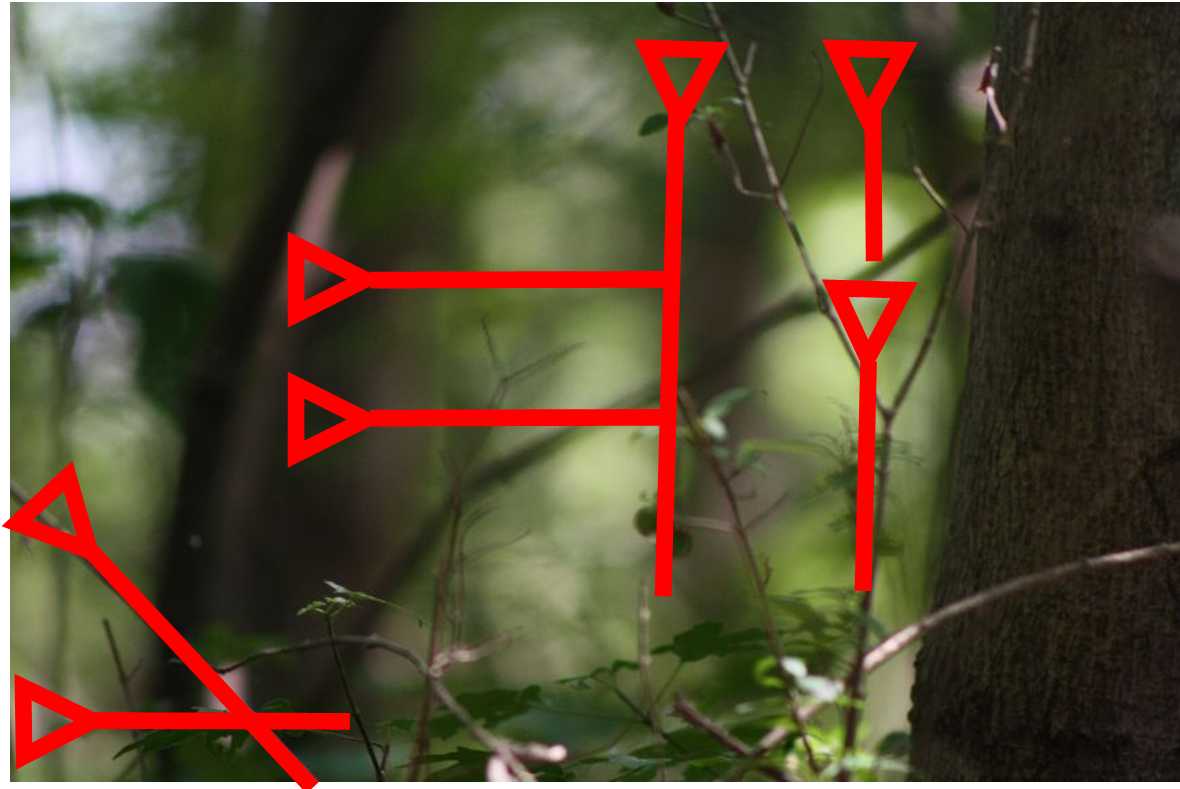
the colour photo with cuneiform |

the thresholded #7 |
The mirror-symmetric photo to #7 is (24-7) = #17, which exhibits much of the same material but with the lefthand third moved over to the righthand side:
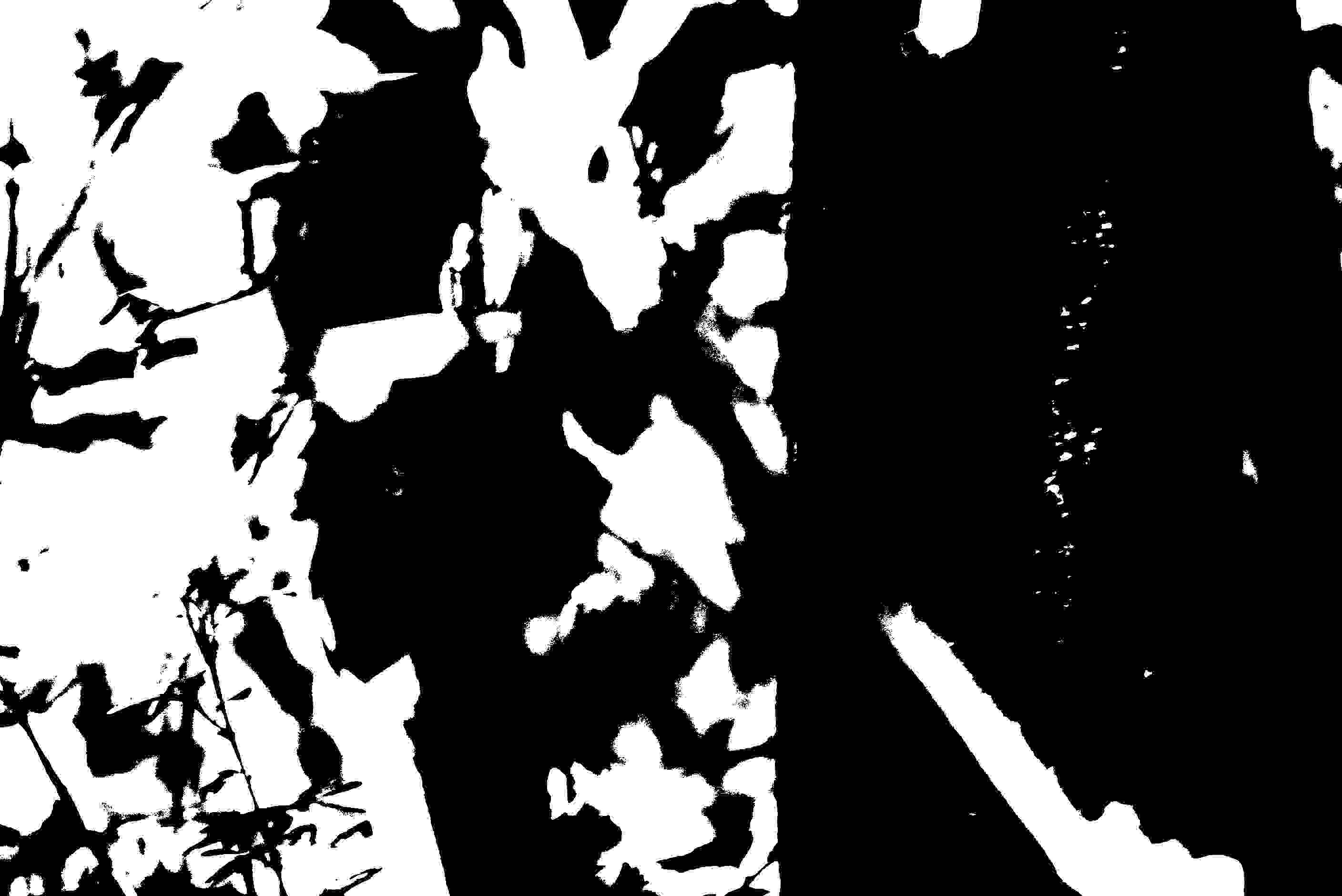
Here the diagonal of the stairs on the left is moved over to a formal structure on the right. Interestingly, the sumerian form E.PAP.E = ![]()
![]()
![]() is a plural form of 'Kanal' = 'Wasserlauf' - and the location of the helicopter vision was at the riverside at the Danube island where I took the photos - this island is in the middle of the Danube which thereby splits in two channels there: I walked the riverside road to the left - the grove where I took the photos are on the island up right - the distance could be perhaps 200 metres or somewhat more - maybe 300. A bridge crosses over to the island between the two locations - there are several bridges to the left and right of the margins of this photo.
is a plural form of 'Kanal' = 'Wasserlauf' - and the location of the helicopter vision was at the riverside at the Danube island where I took the photos - this island is in the middle of the Danube which thereby splits in two channels there: I walked the riverside road to the left - the grove where I took the photos are on the island up right - the distance could be perhaps 200 metres or somewhat more - maybe 300. A bridge crosses over to the island between the two locations - there are several bridges to the left and right of the margins of this photo.
This movement from left to right can be imitated in photo #3 turned upside down - then showing two 'birds' being shot out from the shooter's 'tool', an ancient sort of 'gun' it looks like, as if attracted by the giant female breast just in front of him and the more general female body shape up and in front of him - could be like the Madonna before the children in Fatima. On the left is now the ancient 'axe' with the long diagonal handle:
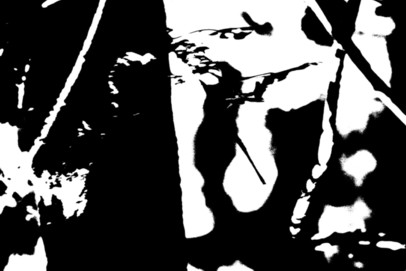
Here the formal diagonal is on the lefthand side again and the two 'birds' are on the middle or righthand side. The giant breast can be seen to be represented graphically in the cuneiform sign
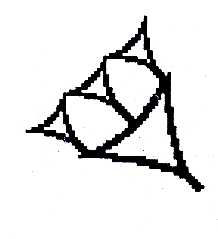 = HI, ŠÁR
= HI, ŠÁR
ŠÁR = (among other meanings) 'herauskommen lassen', 'Lebewesen (hinaus)-schicken' - like the release of those 'birds' - or its quasi 'reciprocal' sign:
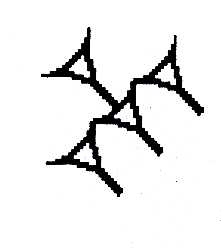 = 'ŠE' = 'Gerste', 'Getreide', 'Korn', 'Nahrung', 'Feuer'
= 'ŠE' = 'Gerste', 'Getreide', 'Korn', 'Nahrung', 'Feuer'
This can be combined with
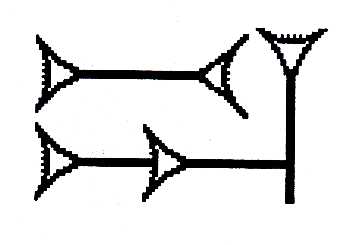 = DU = 'gehen', 'herumstreifen', 'wahr', 'schreiben', 'ausreissen', 'Eilbote'
= DU = 'gehen', 'herumstreifen', 'wahr', 'schreiben', 'ausreissen', 'Eilbote'
for my walking along the riverside, for the resulting
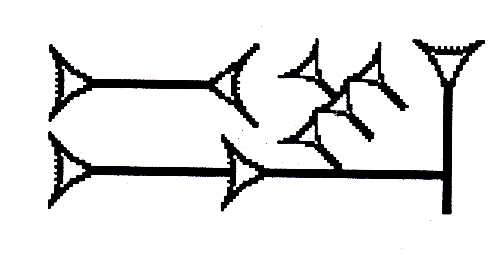 = KAŠ4 (DU-šeššig) = 'Lauf', 'laufen', 'schnell', 'Kurier', 'Fremder'
= KAŠ4 (DU-šeššig) = 'Lauf', 'laufen', 'schnell', 'Kurier', 'Fremder'
which combined with the
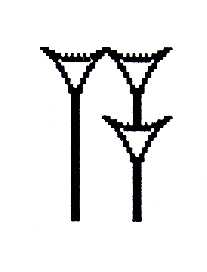 = A = 'Wasser'
= A = 'Wasser'
should allow for the combined

 = A.KAŠ4
= A.KAŠ4
for the idea of 'Wasser-Lauf' = the Danube river. The two lower horizontal wedges would then be the road I walked on, or my own progress, while the slanting 'ŠE' = 'Gerste', 'Getreide', 'Korn', 'Nahrung', 'Feuer' would be the helicopter formation passing on my lefthand side - like rightwards in this script. The three ordinary military helicopters were in formation 1-3-5 while the two heavy transportation helicopters were interlaced 2-4 - and they all gave the impression of advancing rather low over the water (in spite of the numerous bridges in the area) in a slanting posture, such that each helicopter was progressing in a somewhat diagonal or 'oblique' position - cp. the hieroglyphic 'two flowering reeds' = 'y' which also can be notated with two oblique strokes '\ \'.
It should be possible to recognize this also in Tizian's 'Ariadne & Bacchus' - Ariadne as the A = 'Wasser' to the left and Bacchus as the ŠE = 'Nahrung', 'Feuer'.
Now for the clue: Sumerian for 'prayer' ('Gebet') is (by Hübner/Reizammer's 'Deutsch-Sumerisch') 'ér' = A.IGI, a form which also can mean 'Träne' - the teardrop in Ablikhos' poem.

A |
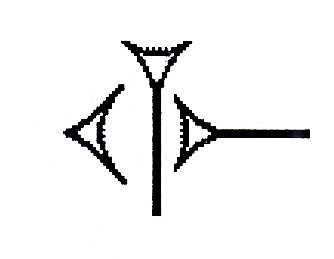
IGI |
With the A = 'Wasser' and IGI = 'Auge', 'Antlitz', 'Gesicht', 'Zeuge', 'sehen' and 'Reziproke' (math)., there arises the natural redundancy of the faculty of vision in this apparition being the same as the Danube river - the Don-Au[g]. It splits in two (E.PAP.E = plural of 'Kanal', 'Wasserlauf') at the island in the river where I took the 23 photos - just some 100-200 metres from the location where I observed the helicopters (close to 'Donaustadtbrücke').
I refer also to my own TEQ #405 - referring to 'mechanic angels' - and its mirror poem TEQ #1315 where one can recognize the one or two hundred meters crossing of the river (or hundred skating steps?), the 'on/in-prayer' helicopters, the 1 and 2 riverruns etc.
Ablikhos lived from the time of Grassmann to Fatima and one could see his work as being concerned with the symbolism that is not PAP.E-flat.
Sumerian for 'flat' = 'eben sein' = ur5 = HAR =
![]()
Turning this upside down renders something resembling photo #3 upside down:
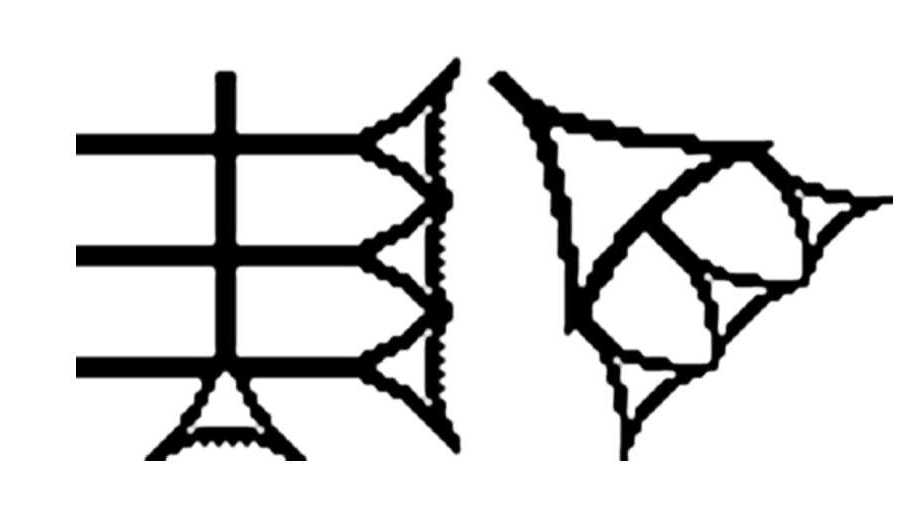

whereby the vertical wedge crossing the three horizontals thereby will be the handle of the 'axe' on the lefthand side.
The HAR sign can have a range of meanings, including 'Ring', 'Mühlstein' (= 'eben sein'), 'durchstreichen', 'diagonal durchteilen' - cp. these elements from Tizian. One recognizes also the character of 'cantorian paperflat diagonalism' which took shape in the span from Grassmann to Fatima.
Cuneiform phonetics
Is this 'paperflat' (from cuneiform 'PAP.E') a too ridiculous association to these symbolisms?
I notice the phenomenon of the cuneiform sign
 = DUG = 'Gefäss', 'Krug', 'Topf' = 'Wasserbehälter'
= DUG = 'Gefäss', 'Krug', 'Topf' = 'Wasserbehälter'
compared with
 |
 = pa5 = PAP.E = pa5 = PAP.E = dug = DUG = dug = DUG
|
The 'crossover' on the left of PAP.E - the slanting wedge crossing the horizontal - is here lifted over to the righthand side in DUG - and under this 'crossover' one can now imagine that there are 2 angels (one 'DUO') that hold 'crystal aspersoriums' (crystal containers for holy water sprinkled during religious ceremony) in their hands - as in the end of the third secret of Fatima. This could therefore be the same as the two transportation helicopters qua 2 teardrops of prayer in Ablikhos' poem.
It is for this reason that the 'paperflat' is perhaps not so ridiculous after all - if the PAP.E could be associated with the essential role of the POPE in this same 'third secret of Fatima' - which tells of how the pope was 'shot down' to the flat ground at the foot of the cross. It could be indicative of the idea that a sort of cuneiform logic is contained in the vision from Fatima - and the third secret itself could have been telling of what a tragedy this 'paperflat' mathematics and its logic has been.
Likewise, there could have developed an administrative logic that felt that it was on the right track when making philosophies of e.g. the type 'DUG.PAP.E' ('do-papir' = 'toilet paper') - relating it to the norwegian poet Petter Dass and his oeuvre - while this more properly would have been about the myth - or reality - of the hypothesized unknown norwegian poet (around the 17th-18th century) whom History had planned through several centuries and who presumably did his work - but when he died, his opus - some papers in a box - was just thrown in the garbage (and a strangely transcendent luminosity seemed to come down from the horizon that afternoon - cp. also Fatima-Lucia's mention in the second secret of ' an unknown light') instead of being carried over to the priest who could have stored it in his attic for some decades or centuries. This complete scandal was irrepairable and has a high explanatory value for understanding much of the later limp of history. If Norway were established in 1814 for preventing this from happening again, a misinterpretation could later have arisen in the temptation that it was not for preventing it from happening again that the state was established - but on the contrary because it had been right - and this led to nazism under Adolf Hitler.
A tragic version of christendom could also have developed which considers the role of Christ to be a sort of 'loopaper' on the cross - the humans should have been punished for their sins but he took the punishment for them (paid the 'ransom') and so the humans could go free and continue sinning as before. Such 'paperflat' theology seems to forget that Christ as divine is squeezed into the narrow existential conditions of the humans - those human existential constraints are what his life tells of - and thereby we are enabled to understand what the larger reality is or could be about.
Conclusion
Conclusion on these matters seems to be that the lefthand side of photo #7 can be moved over ('crossover') onto the righthand side of the (mirror) photo #17 via the cuneiform interpretation of photo #3 turned upside down. Is there a ring-dance around a symbol on the flat ground in the (mirror) photo #(24-3) = #21? I notice that the sign could look like 'hammer & sickle', as in the KUA sign qua schimmelbild with this 'sickle' and this 'hammer'.
It seems to be this aspect which allows for the poem of Ablikhos to be associated with the miracle of the sun in the Fatima revelation - and the following russian revolution - in my observation of the helicopters on my walk along the Danube river on 22 september 2013.
PS The name of 'Μικελης Aβλιχος' = 'Mikelis Ablikhos' is normally transcribed 'Avlikhos' or 'Avlichos' or something similar in modern greek, but Aristotle would have called it 'Ablikhos'. There are various conventions for the transcription.
Sources:
http://vivl-lixour.kef.sch.gr/?page_id=553&lang=el - the source for the poems of Ablikhos.
(I though the page were down for a while but I had mis-spelt the URL with an apostrophe for the question mark).
Weber, H.: Lenin. Rowohlt 2001.
Ellermeier, F.: Sumerisches Glossar, Band 1, Teil 1. Sumerische Lautwerte, Lieferung 2. Theologische und orientalische Arbeiten aus Göttingen 4. Selbstverlag Dr.Friedrich Ellermeier. Nörten-Hardenberg bei Göttingen 1980.
ELLERMEIER/STUDT, Sumerisches Glossar, CD-ROM zu SG 3,3
Hübner, B. & Reizammer, A.: Inim Kiengi. Sumerisch-Deutsches Glossar (+ Deutsch-Sumerisches). Selbstverlag Dipl.-Ing.Univ. Albert Reizammer, Wichernstr. 3, 8590 Marktredwitz 1985.
Kennedy, I.G.: Tizian. Taschen, Köln 2018.
© John Bjarne Grover
On the web 28 august 2023
Last updated 3 september 2023